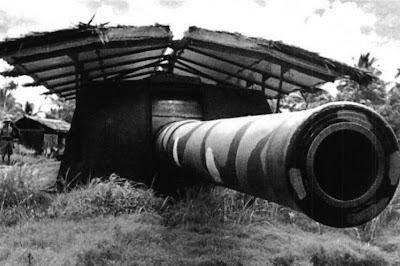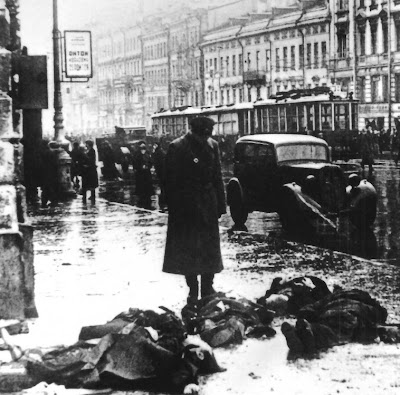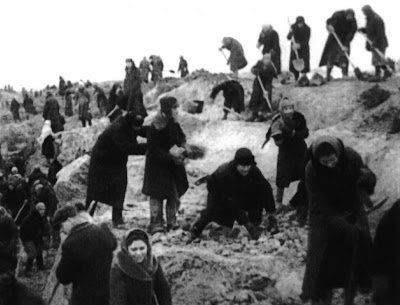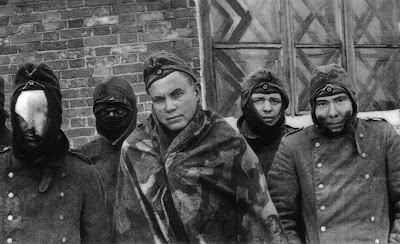
In mid 1941, America reacted to Japanese occupation of French Indo-China by freezing Japanese assets. In October Prince Konoye's moderate cabinet was replaced by a government headed by General Tojo, and, despite the recognition by several leading figures that she could not win a long war, Japan prepared a devastating strike. On December 7, carrier-borne aircraft struck the U.S. Pacific Fleet at Pearl Harbor, on the Hawaiian island of Oahu. Surprise was complete, although the Americans had received warnings which should have enabled them to meet the attack. American losses were heavy, but aircraft carriers were at sea and escaped the carnage.
Above, Battleship row at Pearl Harbor. From left to right are the
USS West Virginia,
Tennessee and
Arizona. All three, along with the battleships
California and
Nevada eventually sank, but only
Arizona and
Oklahoma were total losses.

Anti-aircraft fire bursts among Japanese aircraft attacking the U.S. Pacific Fleet. The Japanese lost 29 aircraft.
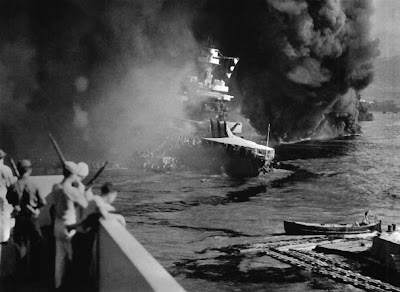
Small craft rescue survivors from the battleship
USS California, sunk by Japanese aircraft. The Americans suffered over 3,000 casualties in the attack.

Roosevelt denounced December 7 as “a date which will live in infamy,” and, here, grim-faced, signs a declaration of war against Japan. Some historians have suggested that the Japanese attack gave him a pretext for action he wished to take in any event, but the extant evidence does not prove his complicity in what may best be seen as “the ultimate intelligence blunder.”
 The fall of Malaya and Singapore left the Japanese free to turn their attention to Burma, where the British were to wage their longest Second World War campaign. Yet it was certainly not an exclusively British campaign, for Indian and African troops, along with combatants from many of Burma's indigenous peoples, fought in it, and American aircraft and special forces played their own distinguished part. Invasion proper began on January 19, 1942, the Japanese cut the land route between India and China in April, and by May the surviving defenders, now commanded by Lieutenant General “Bill” Slim, had reached the borders of India after a gruelling retreat. The photograph above, which just predates the Japanese invasion, shows Indian troops, upon whom the defence of Burma largely depended, marching past a pagoda.
The fall of Malaya and Singapore left the Japanese free to turn their attention to Burma, where the British were to wage their longest Second World War campaign. Yet it was certainly not an exclusively British campaign, for Indian and African troops, along with combatants from many of Burma's indigenous peoples, fought in it, and American aircraft and special forces played their own distinguished part. Invasion proper began on January 19, 1942, the Japanese cut the land route between India and China in April, and by May the surviving defenders, now commanded by Lieutenant General “Bill” Slim, had reached the borders of India after a gruelling retreat. The photograph above, which just predates the Japanese invasion, shows Indian troops, upon whom the defence of Burma largely depended, marching past a pagoda. The British destroyed much equipment m order to prevent it from falling into Japanese hands. Here the task of demolition goes on.
The British destroyed much equipment m order to prevent it from falling into Japanese hands. Here the task of demolition goes on. Although photographs like this were useful for propaganda purposes, this shot of Japanese entry into the southern Burmese town of Tavoy makes the point that many Burmese regarded Japanese invasion as an opportunity to escape British rule.
Although photographs like this were useful for propaganda purposes, this shot of Japanese entry into the southern Burmese town of Tavoy makes the point that many Burmese regarded Japanese invasion as an opportunity to escape British rule.


